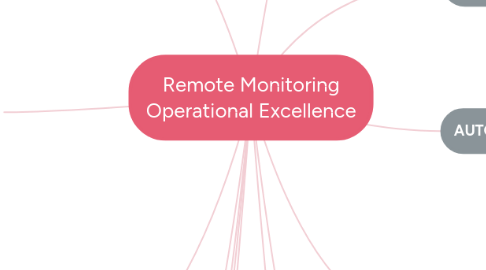
1. SERVICE DELIVERY
1.1. Remote Technical & Clinical Expert (RSE - Remote Service Engineers)
1.2. Customer Care Central Helpdesk
1.3. Proactive Service Delivery
1.3.1. Proactive Monitoring
1.3.1.1. tools & Reports
1.3.2. Automated remote Diagnosis (Potential Alerts)
1.3.2.1. Philips e-Alert
1.3.3. Planned Schedule Maintenance
1.3.3.1. tools ?
1.4. Service Catalogue
1.4.1. Hardware
1.4.2. Software
2. REMOTE SERVICES SCORE CARD
2.1. Direct KPI
2.1.1. Remote Diagnosis Fix
2.2. Indirect KPI
2.2.1. True Reachability
2.2.2. Touch by remote
3. PROGRAMS & INITIATIVES
3.1. Knowledge Management Portal Creation
3.2. HECTOR - A drivie on RADAR (New NPI)
3.3. IOT Implementation
3.4. EAlert Ssytem (EAS)
3.4.1. Out of Spec it will send alert to hospital
3.4.2. External Sensor
3.4.2.1. Magnetic Sensor
3.4.2.2. Humidity Sensor
3.4.2.3. Cooling Sensor
3.4.3. Power quality Sensor ( New Change)
3.4.3.1. Magnetic Quench
3.4.3.2. Detect and Inform the field
3.5. Remote Diagnostic Model
3.5.1. Analytics Solution Program
3.5.1.1. Look for Error Patterns
3.5.1.1.1. Proactive Monitoring (RMW)
3.5.1.1.2. Reactive Monitoring (RSW)
3.5.1.1.3. Remote Connectivity Workspot (RSW)
3.6. Improve Reliability of Coils
4. MONITORING
4.1. Magnet Monitoring
4.1.1. M2M Alerts
4.1.1.1. Scannered to be switched ON
4.2. Helium Monitoring
4.3. Pressure Alerts
4.4. Quench Alerts
4.5. M2M Alerts
5. VOICE OF CUSTOMER
5.1. Remote Services Survey
5.2. Interview with Markets
6. Markets
6.1. NSS
6.2. Field Response Team
6.3. Field Support Engineer
7. TOOLS
8. PAIN AREAS
8.1. Customers
8.1.1. Remote Support Contact not provided for Hospitals whose equipment's do not have maintenance contracts/ Customer unhappy
8.2. RSE
8.3. ROC
8.3.1. Workflow Efficiencies
8.4. Remote Infrastructure Space
8.5. Markets
8.5.1. Remote Monitoring Data models for PM are irrelevant and not helping markets or RSE get the triggers needed to perform their job
8.5.1.1. Requirements from markets are not factored for building these data models
8.5.1.2. Sealed magnets temperatures / Cooling system down / Cold head poor performance / Magnet related alerts are the hygiene factor requirement and missing in our data models
8.5.1.2.1. Sealed magnet Reports (As Is)
8.5.1.2.2. 4 Hours SLA if breached could lead to Penalty
8.5.1.2.3. Cost of Non Quality to Lack of Data
8.5.1.2.4. NPS Score for Sealed Magnets from Markets
8.5.1.3. E -Alerts System is not part of the BOM and Major reason for alerts not being captured correctly.
8.5.2. Requirement Gathered from Markets to be prioritized and Initiatives launched with timelines
8.5.3. Incentre 2 Documentation is missing
9. PROCESS IMPROVEMENTS
9.1. Knowledge Management
9.1.1. Process and Tools
9.1.2. Service Max
9.2. IAP Serviciability Program
10. AUTOMATION
10.1. PROGRAMS
10.1.1. FCO UAL Automation
10.1.2. IOT Implementation
10.2. LEAN
10.3. Continuous Improvement
11. CAPABILITY
11.1. Infrastructure
11.2. People
11.3. Training
11.3.1. RSE Engineers
11.3.1.1. Curent Skil Gqap
11.3.2. FSE and RSE Engineers
11.3.3. Hospitals and Clinicians
11.3.4. NSS Engineers
11.3.5. FRT
12. ANALYTICS & REPORTING
12.1. Proactive Monitoring
12.1.1. RADAR
12.1.1.1. The auto alerts to RSE are sent 3 hours after the generation of alerts in the tool and the threshold set is 100 whereas the ideal threshold could be 30 /40 https://radar2.eu-west.philips-healthsuite.com/#/system/Dashboard
12.1.2. QLIKVIEW
12.2. Reactive Monitoring
12.2.1. SALESFORCE
12.2.1.1. To understand the reactive alerts https://pww.portal.rs.healthcare.philips.com/PrsPortal/Default.aspx?PrsID=42077
12.3. TOOLS
12.3.1. PRS (Philips Remote Services Portal)
12.3.2. ASP (Analytics Service Platform)
12.3.3. DAW
12.3.4. RSW ( Remote Services workSpot)
12.3.5. RADAR
12.3.6. IAP (Imaging Acquisition Platform)
12.3.7. RMW (Remote Monitoring Workspot)
13. Governance and Actions
13.1. KPI Reporting
13.1.1. TTSU
13.1.2. Remote Resolution
13.1.3. Remote Disgnosis
13.1.4. FVF
